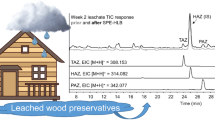Abstract
The purpose of the investigations reported was a feasibility study of field asymmetric ion mobility spectrometry (FAIMS) applications for the characterization of recovered wood. Especially the treatment with organic wood preservatives represented by their active substances should be detected in concentrations commonly used for timber products. The following pesticides were determined: PCP, lindane, dichlofluanide, tolylfluanide, propiconazole, tebuconazole, IPBC (iodine-propyl-butyl-carbamate), K-HDO ((N-Cyclohexyl-diazeniumdioxy)-potassium) and fenoxycarb. The first step was to show that such compounds can be vaporized under moderate conditions. Solid-phase microextraction (SPME) was capable for sampling and enrichment. The reference analytics was made by gas chromatography coupled with mass spectrometry (GC-MS). Both, waste wood, in this case window frames from reconstruction work, and self-prepared doped wood samples were utilized. For analyzing the complex mixture of vaporized native and artificial ingredients of the lignocellulose material a chromatographic pre-separation was necessary. Hence, the second step was to study the behavior of active substances in the analysis with GC-FAIMS to clarify which peaks in positive and negative mode are dedicated to wood preservatives. At least one strong signal from every selected active compound was located for clear identification. With that knowledge, FAIMS was successfully applied for the distinction of natural and treated wood samples. The discrimination can be a basis for industrial sorting plants which could help to increase the contemporary amount of material usage of recovered wood for a more ecological and economical handling of natural resources.










Similar content being viewed by others
References
AltholzV (2002) German ordinance on the management of waste wood (Altholzverordnung)
Baim MA, Hill HH Jr (1983) Halogenated compound response in an oxygen doped ion mobility detector for capillary gas chromatography. J High Resolut Chromatogr 6(1):4–10
Boehncke A, Martin K, Müller MG, Cammenga HK (1996) The vapor pressure of lindane (γ-1,2,3,4,5,6-Hexachlorocyclohexane) a comparison of knudsen effusion measurements with data from other techniques. J Chem Eng Data 41(3):543–545
Buhr A, Genning C, Salthammer T (2000) Trace analysis of pentachlorophenol (PCP) in wood and wood-based products—comparison of sample preparation procedures. Fresenius J Anal Chem 367(1):73–78
Buryakov IA, Krylov EV, Nazarov EG, Rasulev UK (1993) A new method of separation of multi-atomic ions by mobility at atmospheric pressure using a high-frequency amplitude-asymmetric strong electric field. Int J Mass Spectrom Ion Process 128(3):143–148
Carswell TG, Nason HK (1938) Properties and uses of pentachlorophenol. Ind Eng Chem Res 30(6):622–626
Eiceman GA, Karpas Z (2005) Ion mobility spectrometry, 2nd edn. Taylor & Francis, Boca Raton, pp 155–159
Esteve-Turrillas FA, Pastor A, De La Guardia M (2009) Use of semipermeable membrane devices for monitoring pesticides in indoor air. J AOAC Int 92(5):1557–1565
European-Panel-Federation (2011/2012) EPF annual report
Jones D, Brenton AG, Games DE, Brittain AH, Taylor S, Kennedy D, Smith P (1993) Ion mobility spectrometry as a detection technique for the separation sciences. Rapid Commun Mass Spectrom 7(6):561–566
Kanu AB, Hill HH Jr (2008) Ion mobility spectrometry detection for gas chromatography. J Chromatogr A 1177(1):12–27
Karasek FW (1971) Plasma chromatography of the polychlorinated biphenyls. Anal Chem 43(14):1982–1986
Lawrence AH, Barbour RJ, Sutcliffe R (1991) Identification of wood species by ion mobility spectrometry. Anal Chem 63(13):1217–1221
Li F, Xie Z, Schmidt H, Sielemann S, Baumbach JI (2002) Ion mobility spectrometer for online monitoring of trace compounds. Spectrochim Acta B At Spectrosc 57(10):1563–1574
Liu X, Nacson S, Grigoriev A, Lynds P, Pawliszyn J (2006) A new thermal desorption solid-phase microextraction system for hand-held ion mobility spectrometry. Anal Chim Acta 559(2):159–165
Mantau U (2012) Holzrohstoffbilanz Deutschland - Entwicklungen und Szenarien des Holzaufkommens und der Holzverwendung von 1987 bis 2015. Infro, Universität Hamburg
Müller MG, Cammenga HK, Salthammer T, Uhde E (2003) Biocides in the indoor environment: correlation of saturation vapor pressure and test chamber experiments for estimation of concentrations in indoor air. Fresenius Environ Bull 12(6):497–502
Paulus W (2005) Directory of microbicides for the protection of materials: A handbook. Springer, Dordrecht, p 618
Rasmussen J, Felby C, Prasad S, Schmidt H, Eiceman G (2011) Rapid detection of propiconazole and tebuconazole in wood by solid phase desorption: ion mobility spectrometry. Wood Sci Technol 45(2):205–214
Ritchie RK, Rudolph A (1995) Environmental applications for ion mobility spectrometry. Paper presented at the third international workshop on ion mobility spectrometry, Galveston, TX, USA
Rordorf BF (1988) Report on vapor pressure curve. vol AG-88-02P. Ciba-Geigy, Basel, Switzerland
Salthammer T, Uhde E (2009) Organic indoor air pollutants, 2nd edn. Wiley, Weinheim, pp 19–20, 241–243
Schoknecht U, Gunschera J, Peyla A, Marx H-N, Marx G, Schwarz G (1998) Holzschutzmittelanalytik - Daten- und Literaturzusammenstellung für Wirkstoffe in geprüften Holzschutzmitteln. Forschungsbericht, vol 225
Schröder W, Kübler J, Matz G (1999) Measurement stretegies for fast on-site separation of waste wood treated with wood preservatives. Paper presented at the AT-ONSITE, San Antonio
Schumann A, Lenth C, Hasener J, Steckel V (2012) Detection of volatile organic compounds from wood-based panels by gas chromatography-field asymmetric ion mobility spectrometry (GC-FAIMS). Int J Ion Mobil Spectrom 15(3):157–168
St. Louis RH, Hill HH (1990) Electron capture ion mobility spectrometry for the selective detection of chlorinated and brominated species after capillary gas chromatography. J High Resolut Chromatogr 13(9):628–632
Vogt M, Schulze A, Wylamrzy J (2004) Fast detecting methods as instruments for the quality assurarance of recovered wood. Proceedings 1st Conference of COST Action E31, Thessaloniki, Greece
Acknowledgements
Part of this work was supported by the Fraunhofer Internal Programs under Grant No. 823 791. The authors thankfully acknowledge the financial support.
Author information
Authors and Affiliations
Corresponding author
Rights and permissions
About this article
Cite this article
Mauruschat, D., Schumann, A., Meinlschmidt, P. et al. Application of gas chromatography - field asymmetric ion mobility spectrometry (GC-FAIMS) for the detection of organic preservatives in wood. Int. J. Ion Mobil. Spec. 17, 1–9 (2014). https://doi.org/10.1007/s12127-013-0141-5
Received:
Revised:
Accepted:
Published:
Issue Date:
DOI: https://doi.org/10.1007/s12127-013-0141-5




